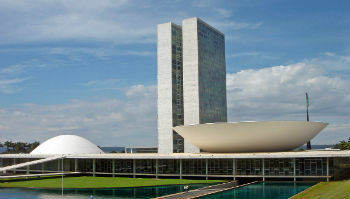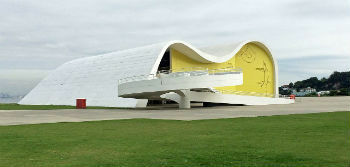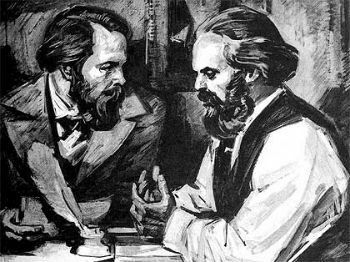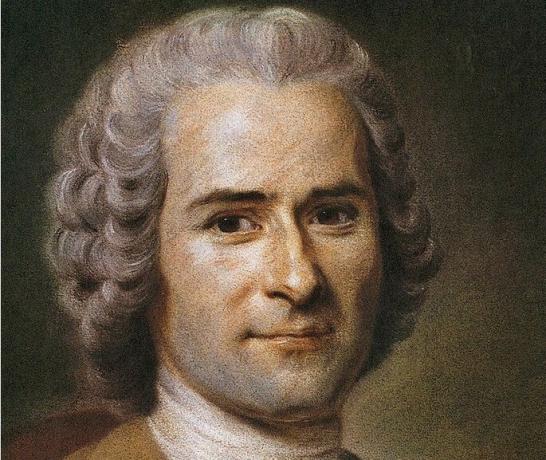Oscar Niemeyer was a modern and contemporary Brazilian architect. In addition to being a renowned architect, he made sculptures, furniture, prints, drawings and even wrote books.
He is well known for the works he carried out in Brasília: the Palácio da Alvorada, the National Congress of Brazil, the Palácio do Planalto, the Federal Supreme Court, the Pantheon of Liberty, the Cathedral of Brasília and the Cultural Complex of the Republic João Herculin.
 National Congress building in Brasilia
National Congress building in Brasilia
In addition, he carried out works in other countries and several exhibitions in Brazil and around the world, with more than 600 projects. His style influenced Brazilian and world architecture. About his work he points out:
“It's not the straight, hard, unyielding, man-made line that attracts me. What catches my attention is the free and sensual curve. The curve I find in the mountains of my country, on the banks of its rivers, in the clouds in the sky and in the waves of the sea. The universe is full of curves, an Einstein universe.”
Biography
 Oscar Niemeyer in 1977
Oscar Niemeyer in 1977
Oscar Ribeiro de Almeida Niemeyer Soares Filho was born on December 15, 1907 in Rio de Janeiro. He studied at Colégio Santo Antônio Maria Zaccaria.
In 1928, at the age of 21, he married Annita Baldo and with her he had a daughter. The following year, he began his studies at the National School of Fine Arts in Rio de Janeiro (now UFRJ).
He completed his Architecture course in 1934 and soon went to work with one of the most renowned Brazilian architects: Lúcio Costa (1902-1998).
There he meets the Swiss architect and urban planner Le Corbusier (1887-1965). In 1968 he was invited by Lúcio Costa to participate in the World's Fair in New York, in the United States.
In 1945 Oscar joins the Brazilian Communist Party (PCB). After two years, he returns to New York as he was appointed to participate in the development of the UN Headquarters project.
In 1949 Oscar was awarded the title of “Honorary Member of the American Academy of Arts and Sciences”.
In 1954 he traveled to Europe to participate in a project to rebuild the city of Berlin, Germany.
In the same year, he worked in Venezuela on the project for the Museum of Modern Art in Caracas. In addition, he was in charge of the architectural project for Ibirapuera Park, in São Paulo.
One of his best-known projects in the park is the Ibirapuera Auditorium, designed by the architect in 1950 and opened in 2005. The cultural equipment has 7 thousand m2 of built area and 4,870 m2 of projected area.
It is interesting to note that until 2014 it was only called the Ibirapuera Auditorium. However, to honor the architect, the city's mayor, Fernando Haddad, sanctioned Law No. 16.046, changing the name of the building to: Auditório Ibirapuera – Oscar Niemeyer.
In Rio de Janeiro, Oscar founded the Module Magazine in 1955, which years later was banned by the military government.
In the late 1950s, Niemeyer was invited by the president Juscelino Kubitschek to participate in the construction of the capital of Brazil: Brasília.
As a result, he was appointed Director of the Department of Urbanism and Architecture at Novacap. After the construction of Brasília in 1960, he worked as coordinator of the School of Architecture at the University of Brasília (UNB) from 1962 to 1965.
In 1963 he was awarded the "Lenin Peace Prize" in the USSR. In the same year he was named an honorary member of the American Institute of Architects (American Institute of Architects) in the United States.
After the 1964 military coup, he traveled to Paris to participate in the exhibition entitled “Oscar Niemeyer, l’ architecte de Brasília” at the Louvre.
In the French capital he opened an office on the Champs Elysées in 1972 and worked there for about 20 years. During this time, he has done projects and exhibitions in France, Italy, Algeria, etc.
In 1988 he received the "Pritzker Prize for Architecture" in Chicago, USA. The following year he received the "Prince of Asturias Award", in the Arts category, from the Principado de Asturias Foundation, Spain.
That same year, Oscar was named an honorary member of the Royal Institute of British Architects in England.
In 1996 he received the "Golden Lion Award at the Venice Biennale", on the occasion of the VI International Exhibition of Architecture.
In 2001, Niemeyer was awarded the title of Architect of the 20th Century, by the Superior Council of the Instituto de Arquitetos do Brasil.
In 2004, his wife Annita Baldo died. In 2005 he received the title of "Patron of Brazilian Architecture", granted by the Chamber of Deputies of Brasília.
The following year, at the age of 98, he marries Vera Lúcia G. Niemeyer. In 2012, her only child died: Anna Maria Niemeyer. In the same year, Oscar Niemeyer died on December 5, 2012, aged 104.
In the words of the architect:
“One hundred years is nonsense, after 70 we start saying goodbye to our friends. What counts is my whole life, every minute too, and I think I went through it well.”
Construction
 Museum of Contemporary Art (MAC), Niterói
Museum of Contemporary Art (MAC), Niterói
With a work influenced by Le Corbusier, Niemeyer was a great artist and his main works:
- Gustavo Capanema Building (Rio de Janeiro)
- Pampulha Architectural Complex (Belo Horizonte)
- United Nations Headquarters (New York, United States)
- Ibirapuera Park (São Paulo)
- Copan Building (São Paulo)
- Alvorada Palace (Brasilia)
- National Congress of Brazil (Brasilia)
- Brasilia's Cathedral
- Marquês de Sapucaí Sambadrome (Rio de Janeiro)
- Memorial of Latin America (São Paulo)
- Oscar Niemeyer Museum (Curitiba)
- Museum of Contemporary Art of Niterói (MAC)
- Cinema Museum (Niterói)
- Eldorado Memória Monument (Pará)
- Administrative City of Minas Gerais
- Oscar Niemeyer Cultural Center - CCON (Goiânia)
- Caracas Museum of Modern Art (Venezuela)
- Principality of Asturias Cultural Center (Avilés, Asturias, Spain)
- Boa Viagem Park (Recife)
- João Goulart Memorial (Brasilia)
- Presidents' Memorial (Brasilia)
- University of Science and Informatics (Havana, Cuba)
- Brasilia Digital Tower
- Square in Astana (Kazakhstan)
Niemeyer Way
 Oscar Niemeyer Popular Theater, inaugurated in 2007, is part of the Niemeyer Way in Niterói
Oscar Niemeyer Popular Theater, inaugurated in 2007, is part of the Niemeyer Way in Niterói
In 2002 the project in Niterói called "Caminho Niemeyer" was inaugurated. It is the second largest architectural complex designed by Niemeyer, after Brasília.
With an extension of 11 km on the beachfront (from the center to the south), the cultural complex houses:
- Oscar Niemeyer Foundation
- Roberto Silveira Memorial
- Niterói Popular Theater
- Juscelino Kubitschek Square
- Petrobras Cinema Center
- Museum of Contemporary Art (MAC)
- Charitas Ferry Station
Bibliography
In addition to technical books on architecture, Niemeyer wrote novels, short stories, chronicles and biographies. Check out some of his main works below:
- My Experience in Brasilia (1961)
- The Form in Architecture (1978)
- Rio - From province to metropolis (1980)
- Architect Conversation (1993)
- Museum of Contemporary Art of Niterói (1997)
- The Curves of Time - Memories (1998)
- Friends Talk (2002)
- And now? (2003)
- Homes Where I Lived (2005)
- My Architecture (2005)
- Without beating around the bush (2006)
- Being and Life (2007)
- Constantine University: University of Dreams (2007)
- Chronicles (2008)
- ? (2004)
Sentences
- “Life takes us where it wants to go. Each one comes, writes their little story and leaves. I see no secret in living life.”
- “I don't care about money. Nor to life itself. Life is a breath, a minute. We are born, we die. The human being is a being completely abandoned...”
- “My work doesn't matter, neither does architecture matter to me. For me what matters is life, us hugging, getting to know people, having solidarity, thinking about a better world, the rest is small talk.”
- “I don't understand who's afraid of open spaces. The space is part of the architecture.”
- “We have to dream, otherwise things don't happen.”
Want to know more about Architecture? Read the articles:
- What is Architecture?
- Contemporary architecture



